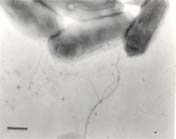Value and reason for sequencing Shewanella woodyi ATCC 51908 was originally isolated from the squid, sediment and water of the Alboran Sea (mixture of Atlantic and Mediterranean Sea) as a bioluminescent bacterium. Like its relative S. sediminis , S. woodyi was also able to degrade RDX with relatively lower activity. Genome sequencing of S. woodyi and S. Sediminis as a pair will help understand how species of Shewanella degraded RDX. Shewanella are ubiquitous in marine environment and play important role in global carbon and nitrogen cycles. S. woodyi and S. sediminis are two bacteria from different geological regions of marine environment and have many complementary properties in carbon and nitrogen metabolism. Genome sequencing and comparative genomics of multiple strains of Shewanella will be used to unlock the genetic processes involved in carbon, nitrogen cycles and biodegradation of pollutants in marine environment. It is used in comparative genomics and in the carbon and nitrogen cycle in the marine environment. It's growth is at low temperature. References Makemson, J. C., Fulayfil, N. R., Landry, W., Van Ert, L. M., Wimpee, C. F., Widder, E. A. & Case, J. F. (1997). Shewanella woodyi sp. nov., an exclusively respiratory luminous bacterium isolated from the Alboran Sea. Int J Syst Bacteriol 47, 1034-1039. Zhao, J.-S., Manno, D., Beaulieu, C., Paquet, L., & Hawari, J. 2005. Shewanella sediminis sp. nov, a novel Na + -requiring and hexahydro-1,3,5-trinitro-1,3,5-triazine (RDX)-degrading bacterium from marine sediment. Int J Sys Evol Microbiol 55, 1511-1520. |
||
|
||
Shewanella woodyi MS32, ATCC 51908

 Transmission electron micrograph showing unsheathed polar flagella. The size bar is 0.5 micrometers. (Provided by Dr John C. Makemson, Florida International University; with permission from IUMS)
Transmission electron micrograph showing unsheathed polar flagella. The size bar is 0.5 micrometers. (Provided by Dr John C. Makemson, Florida International University; with permission from IUMS)